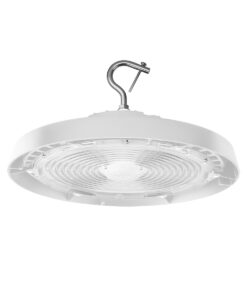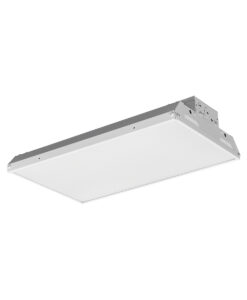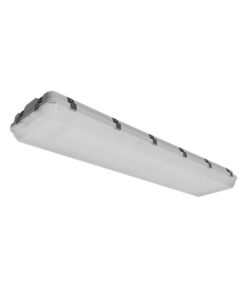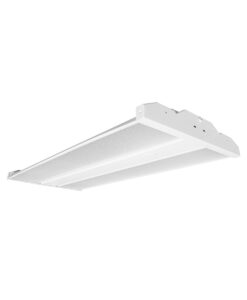At PacLights, we understand the critical role of proper illumination in warehouse operations.
The general lighting load for a warehouse is a key factor in ensuring efficiency, safety, and productivity.
This blog post will explore the intricacies of calculating and optimizing lighting loads for warehouse spaces.
We’ll cover essential formulas, energy-efficient solutions, and best practices to help you make informed decisions about your warehouse lighting system.
What Is General Lighting Load?
Definition and Calculation
General lighting load refers to the total electrical power required to illuminate a warehouse space adequately. It’s a key factor in warehouse operations, directly impacting worker safety, productivity, and energy costs. This load encompasses the power consumed by all lighting fixtures used for overall illumination (excluding task-specific or decorative lighting).

To calculate the general lighting load for a warehouse, we use a formula based on the total floor area and the lighting power density (LPD). The LPD is expressed in watts per square foot (W/ft²) and is used to estimate the Lighting Energy Use Intensity (LEUI).
Factors Influencing Lighting Load
Several factors influence the actual lighting load required:
- Ceiling height: Taller ceilings require more powerful fixtures to provide adequate illumination at floor level.
- Reflectivity of surfaces: Light-colored walls and floors can reduce the number of fixtures needed.
- Racking systems: The layout and height of storage racks affect light distribution and requirements.
- Task areas: Zones requiring higher light levels (such as picking areas or quality control stations) may increase the overall load.
Importance in Warehouse Operations
Proper lighting is not just about seeing clearly; it’s a cornerstone of efficient and safe warehouse operations. Good lighting reduces errors in order picking, minimizes accidents, and improves overall worker morale. The Illuminating Engineering Society recommends light levels between 10 to 30 foot-candles for most warehouse tasks, with higher levels for detailed work areas.
Inadequate lighting can lead to significant problems. A study by the National Institute for Occupational Safety and Health found that poor lighting was a contributing factor in 5% of workplace accidents. Moreover, insufficient lighting can slow down operations, potentially costing thousands in lost productivity.
Optimizing Lighting Load
Meeting illumination standards is important, but it’s equally vital to optimize the lighting load for energy efficiency. Modern LED fixtures can significantly reduce power consumption compared to traditional lighting systems. For instance, replacing metal halide high-bay fixtures with LED alternatives can cut energy use by up to 75%, according to the Department of Energy.
Smart lighting controls can further reduce energy consumption. Occupancy sensors, daylight harvesting systems, and programmable timers adjust lighting levels based on activity and natural light availability. These systems can lead to additional energy savings of 20-60%, depending on the warehouse layout and operations.
Now that we understand the basics of general lighting load, let’s explore how to optimize it for maximum efficiency and cost-effectiveness in warehouse environments.
How to Calculate Warehouse Lighting Load
The Basic Formula
Calculating the general lighting load for a warehouse forms a critical step in designing an efficient and effective illumination system. This process involves more than just basic math; it requires a thorough understanding of your space and its unique characteristics.

The foundation of any lighting load calculation is the simple formula: Total Wattage = Area (sq ft) × Watts per Square Foot. The challenge lies in determining the appropriate watts per square foot for your specific warehouse. The Illuminating Engineering Society (IES) recommends specific footcandle levels to ensure adequate illumination and safety for occupants.
For example, a 50,000 square foot warehouse might require a certain amount of lighting power, depending on the specific needs of the space. This wide range underscores the importance of tailoring your calculations to your unique environment.
Factoring in Warehouse Layout
The layout of your warehouse significantly impacts lighting requirements. High shelving units create shadows and require more powerful overhead lighting or additional aisle lighting. Open floor areas may need less intense illumination but more uniform coverage.
Ceiling Height and Reflectance
Ceiling height is an important factor often overlooked in basic calculations. Higher ceilings require more powerful fixtures to provide adequate light at floor level.
Reflectance of surfaces also plays a significant role. Light-colored walls and floors can increase overall illumination, potentially reducing the number of fixtures needed.
Practical Application
Let’s put this into practice. Suppose you have a 100,000 square foot warehouse with 30-foot ceilings and medium-reflectance surfaces. You might start with a base calculation using the recommended footcandle levels from the IES guide.
This adjusted figure gives you a more accurate starting point for your lighting design. However, this is just the beginning. You’ll need to consider task-specific lighting needs, energy efficiency goals, and potential for natural light integration to fine-tune your lighting plan.
Advanced Considerations
While the basic calculations provide a solid foundation, advanced considerations can further refine your lighting load estimates. Factors such as color rendering index (CRI), uniformity ratios, and glare control all play roles in creating an optimal lighting environment.
For instance, tasks requiring color discrimination may need higher CRI values, which can affect fixture selection and power requirements. Uniformity ratios ensure consistent lighting across the space, potentially necessitating additional fixtures in certain areas.
These advanced considerations underscore the complexity of warehouse lighting design and highlight the value of expert input in the planning process. The next chapter will explore how to optimize your calculated lighting load for maximum efficiency and cost-effectiveness in warehouse environments.
How to Optimize Warehouse Lighting Load
Embrace LED Technology
LED lighting transforms warehouse illumination. These fixtures use up to 70% less energy compared to metal halide or high-pressure sodium lights. LEDs also last longer, which cuts maintenance costs and downtime.
Implement Smart Controls
Smart lighting controls reduce energy consumption dramatically. Occupancy sensors, daylight harvesting systems, and programmable timers can cut lighting energy use by an additional 20-60% (depending on warehouse layout and operations).

Motion sensors in less frequently used areas can reduce lighting time by up to 30%. Daylight harvesting systems adjust artificial light levels based on available natural light and can save an additional 20-40% in areas with windows or skylights.
Optimize Fixture Placement
Strategic fixture placement maximizes lighting efficiency. Use lighting design software to create a detailed plan that accounts for your warehouse’s unique layout (including shelving units and work areas).
Consider task-specific lighting for areas that require higher illumination levels, such as picking zones or quality control stations. This approach allows you to reduce overall ambient lighting levels while ensuring adequate illumination where it’s most needed.
In a warehouse with 30-foot ceilings, placing LED high bays at 25-foot intervals typically provides optimal coverage. However, narrow aisles might benefit from additional aisle lighting at lower heights to eliminate shadows.
Choose Energy-Efficient Fixtures
Select fixtures designed for energy efficiency and longevity. Look for high-quality LED fixtures with excellent lumen output and color rendering. Try to choose fixtures with a lifespan of at least 50,000 hours to minimize replacement frequency.
Some manufacturers offer LED high bay fixtures specifically designed for warehouse environments. These fixtures provide excellent light quality and distribution, ensuring uniform illumination across your space.
Implement Regular Maintenance
Regular maintenance ensures your lighting system operates at peak efficiency. Schedule periodic cleaning of fixtures and lenses to maintain light output. Replace burnt-out bulbs promptly to avoid strain on other fixtures. Conduct annual assessments of your lighting system to identify opportunities for upgrades or improvements.
The general lighting load for a warehouse impacts operational efficiency, safety, and cost-effectiveness. LED technology has transformed warehouse illumination, offering substantial energy savings and improved light quality. Smart controls and strategic fixture placement enhance these benefits, allowing for dynamic lighting adjustments based on occupancy and natural light availability.

We anticipate exciting developments in warehouse lighting technology, including the integration of artificial intelligence and machine learning into control systems. The increased use of human-centric lighting in industrial spaces may improve worker alertness, productivity, and overall well-being. The rise of automation and robotics in warehouses will likely lead to new lighting requirements and innovative solutions.
At PacLights, we strive to stay at the forefront of these advancements. Our energy-efficient LED fixtures and smart control systems meet the diverse needs of modern warehouses. We help businesses optimize their lighting loads while improving operational efficiency (without compromising on quality or safety).






Disclaimer: PacLights is not responsible for any actions taken based on the suggestions and information provided in this article, and readers should consult local building and electrical codes for proper guidance.